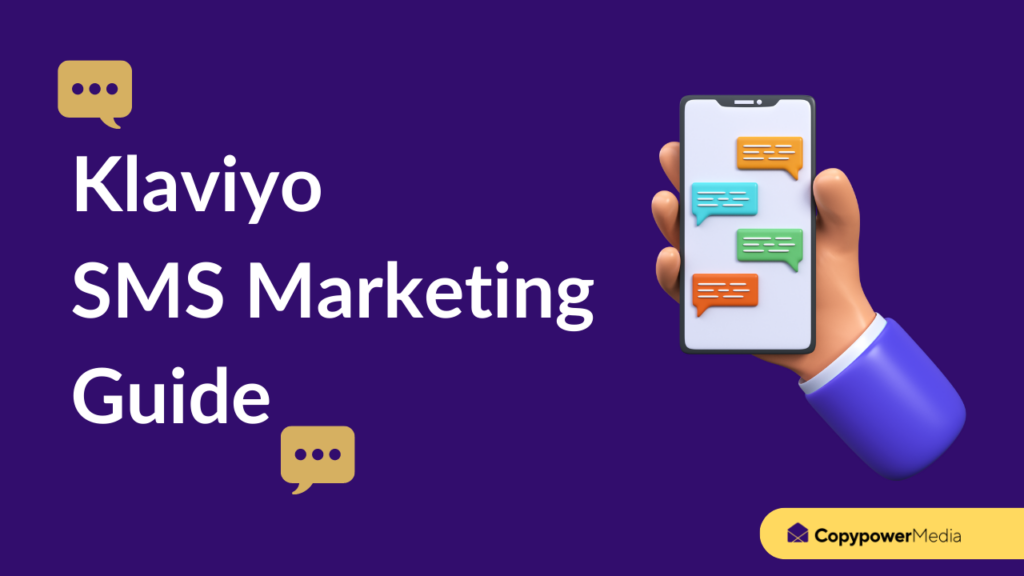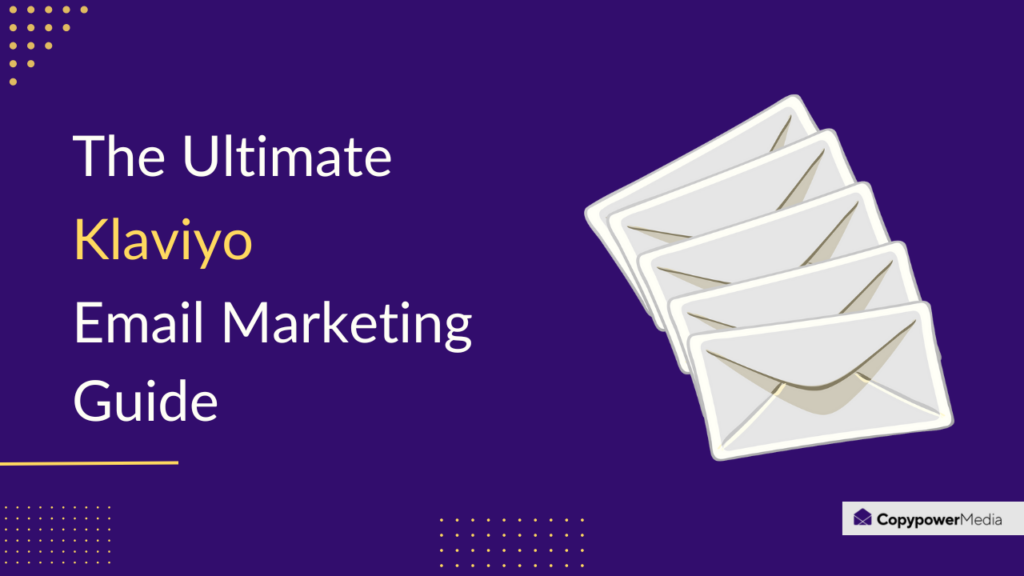In this article, we are going to compare and contrast Kajabi vs Thinkific online course platforms to help make an informed decision.
When it comes to creating and selling online courses, two major platforms stand out: Thinkific and Kajabi. Both platforms offer a wide range of features and tools to help you create, market, and sell your courses.
Which online course platform is right for you? Kajabi or Thinkific? Both Thinkific and Kajabi have their pros and cons. So how do you decide which one is the best online course platform for your needs?
We’ve put together a side-by-side comparison of Kajabi and Thinkific. We are going to cover everything from the background of each platform to its key features, pricing, support, and more. By the time you reach the end of this article, you’ll know which platform will best fit your needs.
Kajabi vs Thinkific: A Quick Overview
If you’re just getting started, here’s a quick overview of Kajabi and Thinkific.
Kajabi
Kajabi is an all-in-one online course platform for course creators that also lets you market and sell your courses online. You can use their drag-and-drop course builder to create courses. Their marketing tools make it easy to promote your courses and drive sales. Plus, Kajabi integrates with many third-party tools to give you a complete solution for running your online business.
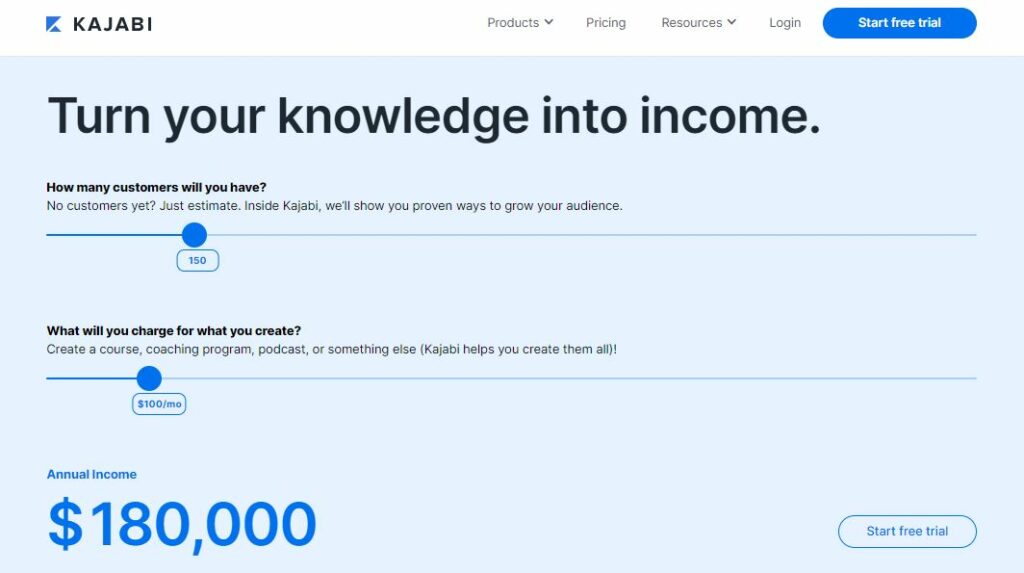

Kajabi is a powerful platform that makes it easy to create, market, and sell course bundles. With Kajabi, you can easily create beautiful course websites, integrate with payment processors to accept payments, and use built-in marketing tools to promote your courses.
Kajabi is designed for course creators who want to simplify their workflow and have everything they need in one platform.
Thinkific
Thinkific is an online platform for course creation that provides you with all the tools you need to build and sell unlimited courses. You can use their powerful course builder to create courses. Thinkfific is loaded with marketing and sales tools to help you promote and sell your courses.
Thinkific is a “self-hosted” platform. That means you don’t need to buy hosting services separately It is included with their offering.


Like Kajabi, Thinkific also offers a wide range of features and integrations. However, one advantage of Thinkific over Kajabi is that it includes a built-in affiliate program, which can help boost course sales. Moreover, Thinkific offers a more affordable pricing plan for small businesses.
Let’s understand the key differences between Kajabi and Thinkific in some more detail
Thinkific vs Kajabi Key Differences
Both online course platforms offer a wide range of features and options, making them well-suited for businesses of all sizes. Here are the key differences between Thinkinfic and Kajabi that you need to consider.
| Features | Kajabi | Thinkific |
|---|---|---|
| Free Plan | Kajabi has a 14-day free trial | Thinkific provides a free plan |
| Number of products | 100 Products | Unlimited courses |
| Number of Students | 20,000 active members | Unlimited students |
| Email Marketing | Built-in templates and automations | Requires third-party apps |
| Live Lessons | Requires third-party apps | Zoom |
| Blog | You can create blogs in Kajabi | You can not create blogs in Thinkific |
| Sales funnels | You can create sales funnels in Kajabi | You cannot create sales funnels in the Thinkific |
| Mobile application | Kajabi has a mobile app | Thinkific does not have a mobile app |
| Course completion certificates | Kajabi does not give completion certificates | Thinkific provides the course completion certificates |
Now that you know a little bit about the Kajabi and Thinkific, let’s dive deeper into the features of Thinkific & Kajabi.
Kajabi vs Thinkific: Course Creation Comparison
When it comes to creating course structure or design options, Kajabi has a slight edge over Thinkific.
Kajabi’s course creation platform is more comprehensive and robust.
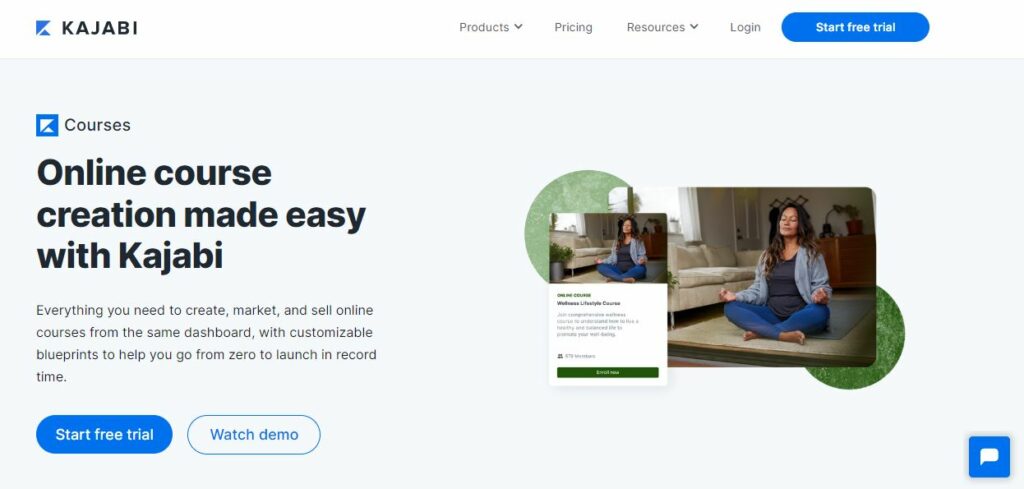

The course builder tool includes a built-in quiz and the ability to hide a particular module unless the quiz is passed. This allows students to be disciplined and follow along the educational path you have designed.
You can upload additional material with each module or lesson allowing the student to study offline.
Kajabi offers 6 types of course templates based on how you want to deliver the content to your students.
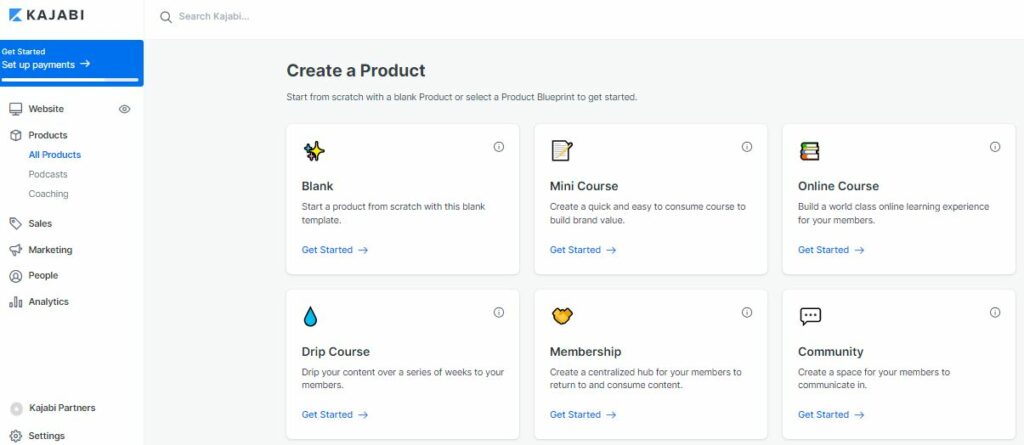

Kajabi also offers the ability to create membership sites and send emails to your list which becomes handy when promoting new content or products.
Thinkific, on the other hand, is a simpler platform for course creators that focuses on courses and learning materials.


Thinkific’s course builder is one of the best in online education because it is user-friendly and focuses on what matters.
While creating or editing your courses in Thinkific, you have access to a wide range of tools such as chapter creation capabilities and adding videos into lessons. You can also add quizzes to keep students engaged throughout their learning experience.
Kajabi vs Thinkific Course Creation: The Winner
Overall, both platforms are great for creating online courses but Kajabi is slightly more comprehensive. It is ideal for those who need a bit more flexibility. However, If you are looking for an easy-to-use platform with a great learning experience, Thinkific might just fit the bill.
Kajabi vs Thinkific: Website Builder
Website builders are a fantastic way to get your website up and running without having to learn to code or hire a web developer. Both Kajabi and Thinkific have excellent website-building tools.
Let’s take a look at Kajabi’s website builder first.


Kajabi offers an extensive website builder that allows users to create custom landing pages, sales pages, and other types of web content. Kajabi’s page builder is easy to use and includes a wide range of features, making it a good choice for businesses that want to create a professional-looking website. However, it does not offer as many customization options.
Kajabi has a drag-and-drop builder. You can add a variety of content such as text, images, and videos to your web page without having to write a single line of code. Thinkific, on the other hand, offers more flexibility and customization options but requires some basic coding knowledge.


Thinkific’s website builder includes fewer features than Kajabi, but it is easier to use and offers more flexibility in terms of customization. Though Thinkific is less extensive than Kajabi, it is still a good choice for creating a simple website.
Kajabi vs Thinkific Website Builder: The Winner
If you want to use pre-made templates for websites and also want to create a blog for your website Kajabi is the better option. But if you want a simple website without all the bells and whistles, Thinkific might be just enough.
Kajabi vs Thinkific Third-Party Integrations
Kajabi and Thinkific both offer extensive integrations allowing you to extend their capabilities. In this area, Thnkific has an edge because it offers more integrations than Kajabi. Kajabi has more out-of-the-box features and the idea is you can get everything inside one platform. While Thinkific is more focused on flexibility and extensibility so you have the freedom to use Third-party applications of your choice.
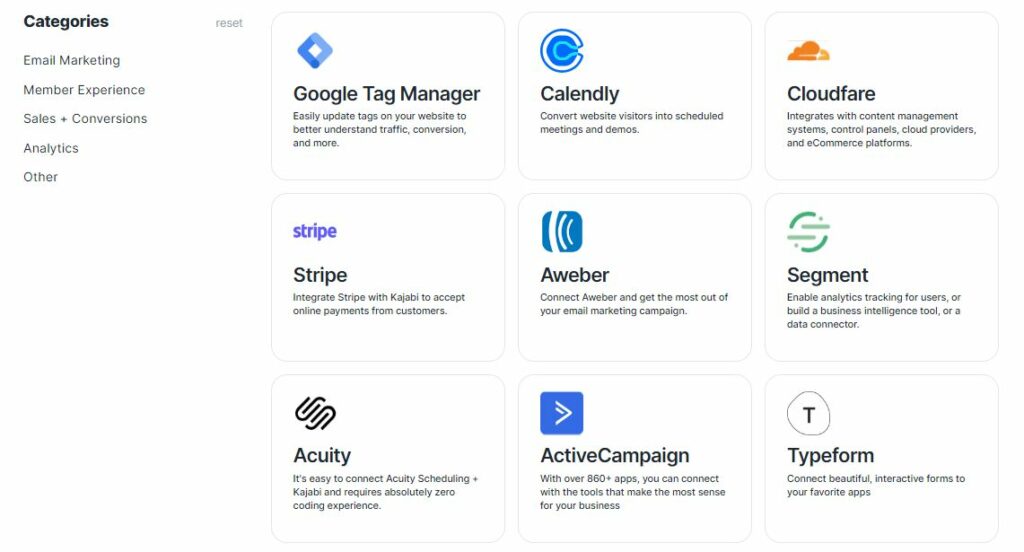

Kajabi provides third-party integrations, including email marketing, selling products, payment processors, and learning management systems.
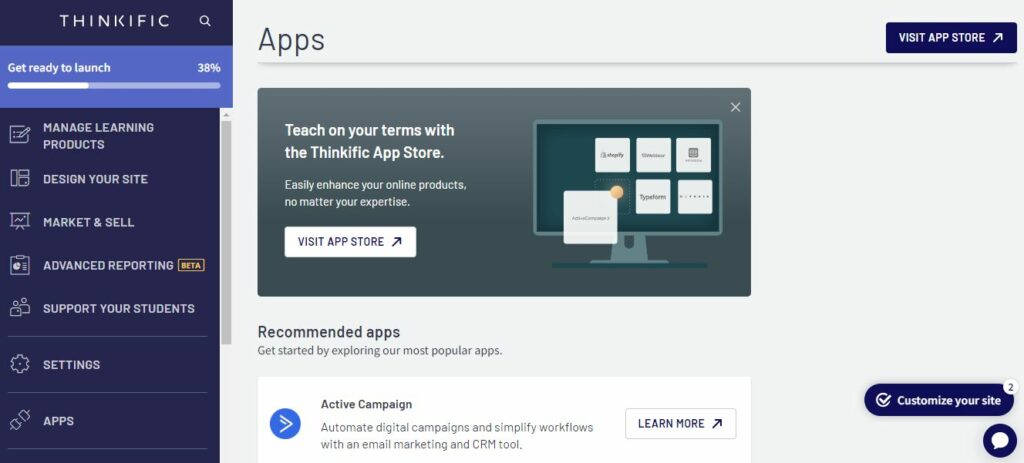

While Thinkific integrates with over 70 external marketing apps and marketing tools through the Thinkific app store.
Kajabi vs Thinkific Third-Party Integrations: The Winner
Thinkific wins here as it provides more third-party integrations than Kajabi.
Kajabi vs Thinkific Student Experience
Kajabi provides more flexibility when it comes to structuring your courses. You can choose from a variety of different lesson types. You can also create custom paths for your students to follow.
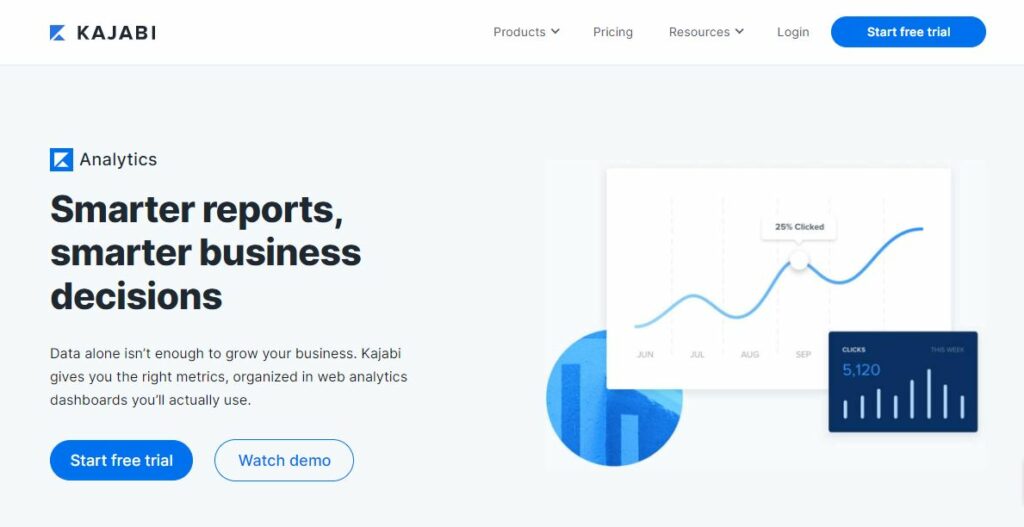

Kajabi offers you the ability to add videos, images, and other content types so that your online course can be tailored for better learning. It offers several themes which help customize it based on the type of material needed in your course.
Kajabi mobile application also comes with some cool features like “magic links” where students can access content without passwords and get credited towards whatever lesson they’re following at any given time.


Students can also save their progress across multiple sessions enabling them to pick up the course from where they left off.


Thinkific’s clutter-free and professional classroom experience allows you to focus on your content while taking care of all formatting needs.
Thinkific allows you to easily add all kinds of content, such as text and multimedia files. The student’s dashboard is clean with an aesthetically pleasing design that makes it easy for them to understand what they need next in their coursework or the progress they have made so far.
Some notable features include progress indicators, unlimited replays, and language controls so that you can focus on your lessons without worrying about Media or Player load times.
It also has built-in completion certificates as well as automated emails which will remind students about what they need next step in their learning process while keeping track of everything else going forward seamlessly from start to finish.
Kajabi vs Thinkific Student Experience: The Winner
When it comes to the student experience, Thinkific has an upper hand over Kajabi. Thinkific provides a more engaging experience for the students. The dashboard motivates students and displays their progress. You can also work closely alongside Thinkific’s onboarding team in order to develop a completely customized student experience.
Kajabi vs Thinkific: Sales and Marketing
Sales and marketing are the most critical aspects of your online business. Let us look at how Thinkific and Kajabi play out in this area.
Kajabi offers substantial sales and marketing features, including landing pages, email marketing, and digital products. Kajabi is ‘ designed from the ground up to help you deploy marketing and sales funnel across the entire customer journey right from generating leads to making sales.
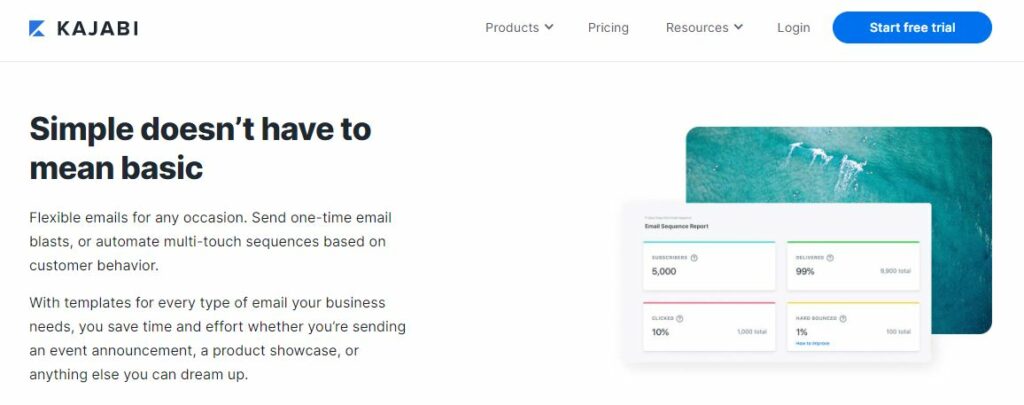

Kajabi also comes with a variety of tools you need to promote your online courses such as email campaigns, marketing automation, discount coupons, and podcasts. Kajabi provides templates designed specifically for different types of promotions such as lead generation, sales pages, or product launches through its pipeline feature.
Kajabi’s email marketing tool also gives it an edge over other course platforms. The visual editor makes it easy to create beautiful emails that are compliant with a variety of browsers and devices. , It also offers the ability to preview your campaign before you hit the send button.
On the other hand, Thinkific’s marketing and sales features can be accessed by clicking on the “Market & Sell” option from your dashboard. It allows you to sell memberships, and subscriptions, run promotional deals on discounts and offer free trials for certain products or services.
You can also use their customizable widgets so that students can make the purchase right away without hassle.


In addition, Thinkific’s affiliate marketing program increases exposure by putting links up all over while getting paid every time for a new sign-up.
Thinkific allows students to make payments in one hundred different currencies and accepts all major credit cards. It also works with PayPal and Stripe for quick and secure payments.
Kajabi vs Thinkific Sales Marketing: The Winner
Since Kajabi includes an integrated CRM, landing page builder, and other business tools, Kajabi is the clear winner. While Thinkific doesn’t offer comprehensive email marketing functionality, it provides integrations with AWeber, Infusionsoft, MailChimp, and Constant Contact so you can use the email marketing platform of your choice.
Kajabi vs Thinkific Support
When it comes to customer support, both Thinkific and Kajabi take different approaches. Keep reading to find out how.
Thinkific
Thinkific provides support to its customers through its Help Center, premium training site, blog, expert marketplace, and status page. It also has a FAQ section.
Additionally, Thinkific provides customer support through
- Email assistance
- Phone assistance (Monday to Friday, from 9 am to 5 pm PST)
- Video instructions.
- Facebook group
- Onboarding calls (only for Pro and Premier plan users)
Kajabi
Kajabi provides customer service through the following channels:
- 24-hour helpdesk
- Emails
- Onboarding calls
- 24/7 Live chat (only for Pro and Growth plan users)
- Live training
Additionally, Kajabi offers support through training webinars and Kajabi University, which makes it simple to search for nested features.
Kajabi vs Thinkific Customer Support: The Winner
Overall, Kajabi provides a better customer support experience than Thinkific because of its real-time support and access to a comprehensive knowledge base
Kajabi vs Thinkific Pricing
When it comes to pricing, deciding between Kajabi and Thinkific can be a tough decision. On the one hand, Kajabi offers a more comprehensive set of features, including everything from website building to online marketing. On the other hand, Thinkific offers a robust platform at an affordable price point.
Let’s take a closer look at the pricing models of each platform:
Kajabi Pricing


Kajabi provides a 14-day free trial for all three plans:
- Basic: $149/month
- Growth: $199/month
- Pro: $399/month
The Basic plan costs $149/month and has 3 products, 3 pipelines, unlimited landing page builder options, unlimited marketing emails, 10,000 contacts, 1,000 active members, 1 website, and 1 administrator user.
The Growth plan costs $199/month and has 15 products, 15 pipelines, unlimited landing pages, unlimited marketing emails, 10,000 active members, 25,000 contacts, 1 website, and up to 10 administrator users. Kajabi’s growth plan has significant automation and it lets you remove Kajabi branding from your products. It also offers an affiliate program.
The Pro plan costs $399/month and has 100 products, 100 pipelines, unlimited landing pages, unlimited marketing emails, 1 million contacts, 20,000 active members, 3 websites, and up to 25 administrator users,. Advanced automation, the elimination of Kajabi branding from your products, access to the code editor, and the affiliate program are all included in this subscription level.
Thinkific Pricing
Thinkific has four primary price tiers:
- Free: $0
- Basic: $49 per month
- Pro: $99 per month
- Premier: $499 per month
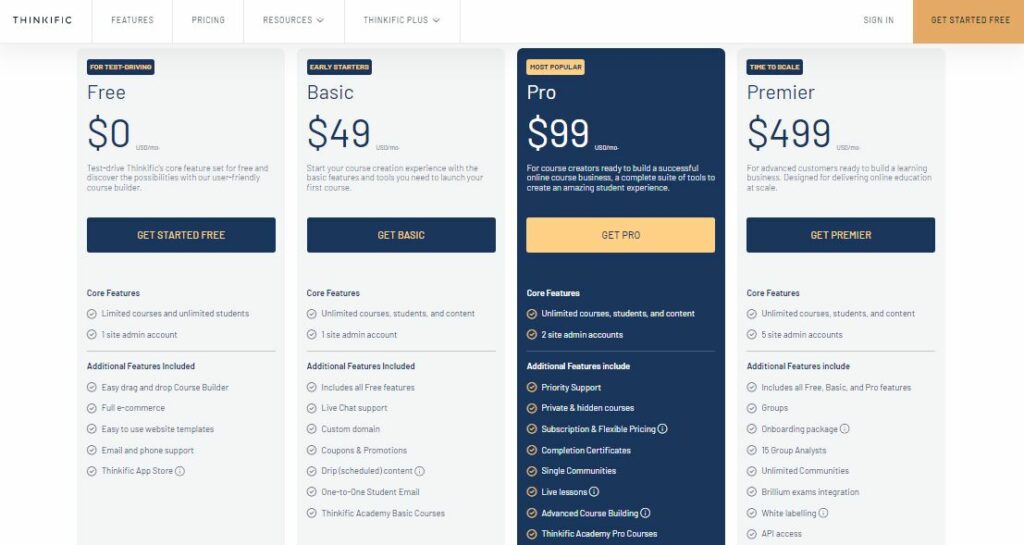

The Free plan provides all the basic features and you can make limited courses with an infinite number of students, 1 site admin, phone and email support, and access to the Thinkific app store. In addition, you have access to content hosting and the ability to design tests and surveys.
The Basic plan costs $49 per month. It includes all of the features from the free plan along with unlimited courses, coupons, 1 site admin, emailing each student separately, drip content, affiliates, reporting, custom domains, live chat support, email integrations, and Zapier triggers.
The Pro plan costs $99 per month and has everything from the free and basic plans along with private and hidden courses, memberships and bundles, certificates, sophisticated customizations, 2 site admins, quiz banks, and assignments.
The Premier plan costs $499 per month and includes everything from the other plans along with 5 site admin accounts, 15 group analysts, unlimited communities, white labeling, and an onboarding package.
Thinkific also has an “add-on” called the Growth Package and it can be added to the “Pro” plan. For the first 100 students, it is free and for every additional 100 students, it costs $10.
Kajabi vs Thinkific Pricing: The Winner
If you’re looking for a comprehensive set of features, Kajabi is the way to go. But if you’re on a tight budget, you can start withThinkific to launch your online business.’s pricing plans.
Advantages of Kajabi
As an online business owner, you know that creating and selling digital products can be a great way to generate income. But if you’re not using the right tools, it can be a real challenge to get your business up and running.
Kajabi comes with a number of advantages that can help you take your business to the next level.
Here are just a few of the advantages of using Kajabi:
- Its core features include pipelines, email marketing tools, a variety of digital products, and pre-built templates.
- You can automate your workflow with Kajabi integrations.
- It provides a comprehensive learning experience to the students.
- It is a great platform to generate leads and close sales.
- It provides blueprints for courses and ready-to-use templates, workbooks, coachings, and more. .
- With Kajabi, you get everything to run your business from one place just by using its drag-and-drop editor.
- Kajabi is a powerful marketing and sales platform that can help you grow your business and track the progress of email campaigns.
Disadvantages of Kajabi
Kajabi is a great online course platform but it also has some disadvantages.
Here are some of the disadvantages of using Kajabi:
- Kajabi is a fairly expensive platform.
- Kajabi can be a bit tricky to use if you’re not familiar with web design.
- Kajabi has an affiliate program only for higher plan users.
- The platform is very customizable, but there’s a learning curve involved.
- Kajabi provides live chat customer support only for Growth and Pro plan users.
- Kajabi only accepts payments through PayPal and Stripe, which is always not a convenient option.
- Course creators can find the interface confusing and difficult to use.
Advantages of Thinkific
Thinkific is an online learning platform that helps businesses create and deliver online courses. The advantages of Thinkific are many and varied, but some of the most important benefits include the following:
- You can customize the look and feel of your courses to match your brand.
- Thinkific is built with SEO in mind so students can easily find your courses online.
- You can offer courses in multiple languages for free or charge a price that you set.
- You have complete control over the course content and delivery of your courses.
- You can use Thinkific’s powerful features to deliver engaging and interactive courses that keep your students coming back for more.
- Thinkific is a good choice for businesses that want to provide a good learning experience for their users
- Thinkfic has an easy-to-use interface that makes course creation a breeze.
- Thinkific integrates with a number of third-party tools, making it easy to add features like quizzes, forums, and gamification.
- Detailed analytics lets you track student progress and engagement throughout the course.
- Thinkific accepts payments from digital wallets like Paypal, Apple Pay, and Google Pay.
Disadvantages of Thinkific
- You have to integrate with third-party applications for advanced marketing and selling features.
- You can not create sales funnels or pipelines in Thinkific.
- It does not offer 24/7 live chat support.
- You can not create a blog in Thinkific.
- The free plan is limited in terms of features and storage.
- It does not offer as many features as Kajabi.
Thinkific vs Kajabi: Which Course Platform is Best For You?
Thinkific and Kajabi both have their pros and cons, so it’s important to consider which one is best for you and your needs.
If you’re just starting out and looking for a simple platform that’s easy to use and doesn’t cost too much, Thinkific is a good option. However, if you’re already established and willing to go all out and play big, Kajabi will be a better choice.


